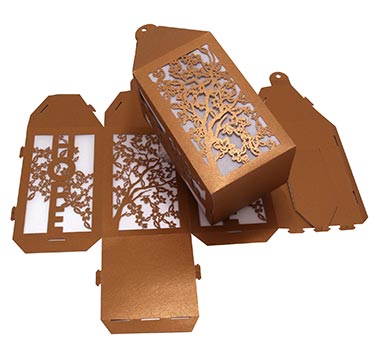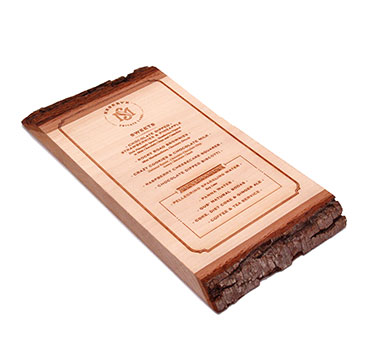We accept the following file formats for laser cutting:
- AI version CS5 or earlier
- PDF with vector art
- DXF compatible with AutoCAD version 2014 or earlier
- DWG compatible with AutoCAD version 2014 or earlier
We can also convert your laser cut files for you:
- Our conversion rate is $75 per hour.
- Just contact us with your particular file format and we’ll let you know if it’s possible.
- If you need us to create a file for you, please see “setting up a sketch” or email us.
Please set up your laser cutting file as follows:
- Laser Cut lines — All lines should be single lines without duplicate/redundant lines. Please REMOVE Clipping masks. All design elements should be joined and expanded.
- Size reference — Include and label a one-inch square size reference in your file.
- AutoCAD files — If you are drawing your parts in AutoCAD, be sure the file is purely two-dimensional.
- Send only one file — The file should include one copy of each unique part with indications of how many of each part you need, as well as the material from which each part should be cut. This information can either be text in the file, or explained in the description section of the quote request form. Please make sure to leave enough space around every part so that we can easily select them by dragging a rectangle around them.
- Multiple files — If you must send more than one file, please use DropBox, YouSendIt or similar file transfer service. You can also zip them and e-mail them or submit them in separate quote request forms through our site. Please explain the materials and quantities you would like for each file as well in your description.
- Acceptable Small Details for laser cutting — The smallest areas which are to remain as paper within your design should be no smaller than 0.025” – 0.030” thick, or 2pt stroke. If we are cutting large designs, this thickness should increase to approximately 0.040” to 0.060”.
- Text for laser cutting or engraving— Text should be converted from a font to line art. This is often called “create outlines (AI)”, explode text to lines or “polylines” in AutoCAD, or “converting text to curves” in other drawing programs. Please also “un-group” your text as well. You could also simply e-mail your font to us. Otherwise, if we do not have the font you are using, our programs will substitute your font with a different one.
Please set up your laser engraving file as follows:
- Vector-engraved lines for laser process — All lines should be single lines without duplicate/redundant lines. Please REMOVE Clipping masks. All design elements should be joined and expanded.
- Raster-engraved solid areas — Raster engraving files can be saved in two ways: “black and white bit map raster files”, and “256 color grayscale raster files”. Use a “black and white bitmap raster file” when a solid tone is needed to be laser engraved. Use a “256 grayscale raster file” when a multi-tonal or photographic laser engraving is needed. These files should be at least 300dpi for the best results.
- Laser Engraving depths — We can vary the laser speed and power to change engraving depths. We will do our best to engrave any depths you specify but we cannot guarantee any particular accuracy with engraving depths. Laser Raster and vector engraving are best for making aesthetic markings and are not suitable making mechanical grooves or features with precise depths.
- First surface and Second surface of laser engraving — We can laser engrave clear and transparent plastic (i.e. Acrylic, Plexiglas, Lucite, PMMA, etc.) from the front (first surface) or back (second surface) of the material. Mirrored acrylic for example is typically laser engraved second surface (the matte gray side) so that when you look at the piece from the front (mirrored side) you can see the engraved areas that have been laser etched into the mirror film on the back.
- Laser engraved Text — Text should be converted from a font to line art. This is often called “create outlines (AI)”, explode text to lines or “polylines” in AutoCAD, or “converting text to curves” in other drawing programs. Please also “un-group” your text as well. You could also simply e-mail your font to us. Otherwise, if we do not have the font you are using, our programs will substitute your font with a different one.
- Files with laser cutting, and laser vector engraving — We can laser cut, and vector engrave a design all as a single job. All images, lines, text, etc. to be vector engraved should be a part of the same file as the cutting file. You do not need to split the laser cutting and laser engraving among different files. Simply place the elements on different layers within your drawing with descriptions of either “laser cut” or “laser engrave”.
- You can send us your idea via a scanned hand drawing or you can draw up a rough sketch on a computer in any file type that we can read.
- The file could be a text file with a written description, or you can create it using AI, Word, Paint, or Excel, etc. and save as (AI, JPG, GIF, BMP, PDF, etc).
- If you would like us to draw or set up your file on the computer for you, you will need to prepare a mock-up of your design or a send us a written description of the design that you need.
Please follow these guidelines when preparing your mock-up file for laser processing:
- Written descriptions should include all sizes of parts, quantities required, and material types and colors for each.
- Mock-ups and scans should include all relevant dimensions (be sure indicate the units of measure you are using).
- Please try as much as possible to make your drawings to scale (please include a 1″ x 1″ square for reference).
- When showing the location of a hole, please specify the distances from the hole’s center to the nearby shapes or edges of the part.
- Include the quantity required for each part needed.
- Multiple files — If you must send more than one file, please use DropBox, YouSendIt or similar file transfer service. You can also zip them and e-mail them or submit them in separate quote request forms through our site. Please explain the materials and quantities you would like for each file as well in your description.

